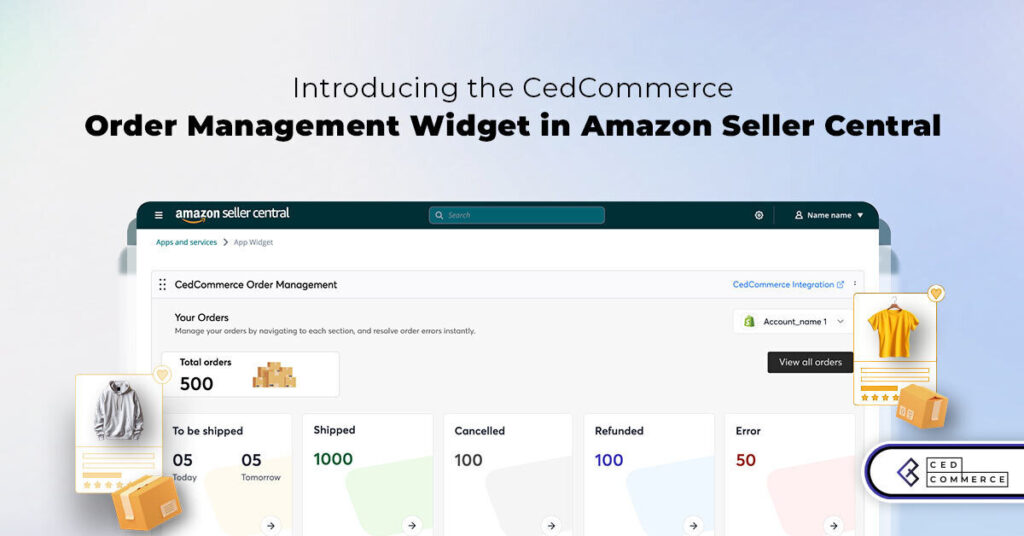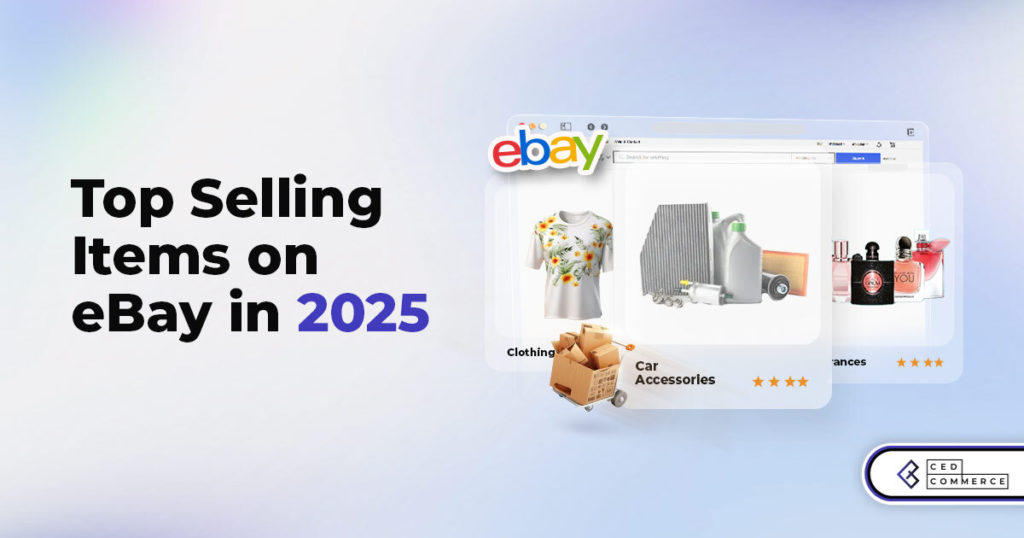Walmart Embraces Amazon MCF: A New Era of Cross-Platform Fulfillment for eCommerce
Walmart Embraces Amazon MCF: A New Era of Cross-Platform Fulfillment for eCommerce
Are you ready to unlock the secrets to a thriving and profitable Amazon seller account? This is a comprehensive guide to Amazon best practices—the ultimate roadmap to success. In the vast and ever-evolving world of eCommerce, understanding and implementing the right strategies can make all the difference. Whether you’re a seasoned seller or just starting out, it is essential to know the dos and don’ts for an Amazon seller account’s success. Moreover, it is absolutely essential to achieving your goals and becoming a successful Amazon seller account holder.
In this blog, you will find instructions and insightful tips to help you navigate the Amazon marketplace with confidence. Furthermore, from optimizing your product listings with Amazon SEO practices to delivering exceptional customer service, this covers all the crucial aspects that contribute to your success. So, dive in and uncover the secrets to a flourishing Amazon seller account!
To achieve success with your Amazon seller account, it is essential to adhere to specific guidelines and best practices on Amazon. In this section, you will discover the key actions you should take to enhance your chances of success. Simply, by paying close attention to these steps, you can maximize your potential and achieve your goals on Amazon.
Remember, your product listings serve as the first point of contact with potential customers. By conducting thorough research, optimizing your content with relevant keywords, and other Amazon SEO practices, you can rank well. Additionally, by using high-quality images, and crafting compelling descriptions, you increase your chances of attracting and converting customers.
Stay tuned for the next section, where we will discuss further dos for a successful seller account on Amazon.
To maximize your success as an Amazon seller, it’s crucial to price your products competitively. Customers are often looking for the best deals, and by offering competitive prices, you can attract more buyers and increase sales. Here are some dos to help you price your products effectively:
Keeping an eye on your competitors’ prices is essential to ensure you are offering competitive rates. Regularly analyze the pricing trends in your niche and adjust your prices accordingly. You can use tools like Amazon’s Pricing Dashboard or third-party software to monitor the market and make informed pricing decisions.
Dynamic pricing allows you to adjust your prices based on factors like demand, competition, or time of day. This strategy can help you stay competitive and optimize your profits. Additionally, bundling products together can offer value to customers and give you a competitive edge. Experiment with different pricing strategies and monitor their impact on sales and customer satisfaction.
Amazon provides various promotional tools to help attract customers and boost sales. Utilize features like Amazon coupons, which offer discounts to customers directly on the product page. Lightning Deals allow you to offer time-limited promotions, increasing urgency and driving sales. By utilizing these tools strategically, you can effectively price your products while creating enticing offers for potential buyers.
Remember, pricing competitively doesn’t always mean lowering your prices to the bare minimum. It’s about finding the value of the offer to customers which helps you to make a profit. Continuously monitor your pricing strategies, analyze their impact, and make adjustments when necessary. By staying vigilant and adapting to market trends, you can position yourself as a successful Amazon seller.
To ensure a successful seller account on Amazon, it’s essential to follow certain dos that can greatly benefit your business. One key aspect is offering Prime eligibility to your customers. By enrolling your products in Amazon Prime, you can enhance their visibility and earn the trust of potential buyers. Here’s what you need to do:
By opting for Prime eligibility, your products become eligible for Prime two-day shipping, making them more appealing to Prime members. This increased visibility can lead to higher conversion rates and more sales for your business.
To provide fast and reliable shipping to your customers, take advantage of the Fulfillment by Amazon (FBA) program. FBA allows you to store your inventory in Amazon’s warehouses, enabling them to handle packing, shipping, and customer service. This not only ensures prompt delivery but also grants you access to Amazon Prime’s fast shipping options.
It’s crucial to stay on top of your inventory management to avoid running out of stock. Running out of inventory can lead to missed sales opportunities and negatively impact your seller metrics. Regularly monitor your stock levels and utilize tools like Amazon’s inventory reports to keep track of product availability. Consider forecasting demand and restocking in a timely manner to maintain a steady supply of your products.
Follow these dos, you can improve the performance of your Amazon seller account. Offering Prime eligibility will attract more customers, and utilizing FBA will provide efficient shipping services. Additionally, maintaining optimal stock levels will ensure that you can meet customer demands without interruptions. Remember, a successful seller account requires proactive management and attention to detail, so stay committed to these practices for long-term success.
To run a thriving Amazon seller account, focusing on exceptional customer service is crucial. By providing prompt and helpful responses to customer inquiries, handling returns and refunds efficiently and professionally, and proactively addressing negative reviews, you can ensure a positive shopping experience for your customers. Here are some key dos to follow for a successful seller account when it comes to customer service:
Respond to customer messages and inquiries in a timely manner. Aim to reply within 24 hours or less, ideally. Be courteous and empathetic in your communication. Use a friendly and professional tone. Address all customer concerns and questions thoroughly. Provide clear and concise answers.
Adhere to Amazon’s return policies and guidelines. Familiarize yourself with their requirements to ensure a smooth return process for your customers. Respond promptly to return requests and initiate the refund process as soon as possible. Communicate clearly with customers about the return and refund process, including any relevant instructions or timelines. Handle returns and refunds professionally, treating each case with care and understanding.
Deliver excellent products and services consistently to increase the likelihood of receiving positive feedback. Follow up with customers after their purchase to ensure their satisfaction. Express your gratitude for their business. Politely ask satisfied customers to leave feedback and rate their experience on Amazon. You can include a brief note or a request within the package or in a follow-up email. Monitor your feedback regularly and respond to positive feedback with a brief message of appreciation.
Regularly check and monitor customer reviews for your products. Stay vigilant about identifying any negative feedback. When encountering a negative review, remain calm and professional. Avoid engaging in arguments or becoming defensive. Reach out to the customer privately to understand their concerns and offer a resolution. Seek to rectify the issue to their satisfaction. If appropriate, respond publicly to negative reviews, showing empathy, acknowledging the problem, and expressing your commitment to resolving it.
By focusing on customer service and following these dos, you can create a positive reputation for your Amazon seller account. Happy customers are more likely to provide positive feedback, recommend your products to others, and become loyal repeat buyers. Building strong customer relationships is a key ingredient in the recipe for long-term success on Amazon.
To ensure your success as an Amazon seller, it is essential to regularly monitor your performance metrics. By keeping a close eye on key performance indicators (KPIs) such as sales, conversion rate, and customer satisfaction, you can make informed decisions and take action to enhance your performance. Follow these steps to effectively monitor and improve your seller account:
Make it a habit to review your performance metrics on a regular basis. Dedicate time each week to analyze your sales figures, conversion rates, and customer satisfaction ratings. This will provide you with a clear picture of how your business is performing and help you identify any areas that require attention.
Take advantage of the analytics tools provided by Amazon. These tools offer valuable insights into your sales data, customer behavior, and market trends. By leveraging this information, you can gain a deeper understanding of your target audience, identify patterns, and make data-driven decisions.
Analyzing your performance metrics will reveal areas where your Amazon seller account can be improved. Look for patterns or trends that indicate underperforming products, low conversion rates, or customer dissatisfaction. Pay attention to feedback from customers and identify any recurring issues or concerns.
Once you have identified areas for improvement, it’s time to take action. Develop a plan to address any shortcomings and implement strategies to enhance your performance. For example, if your conversion rate is low, consider optimizing your product listings, improving product images, or offering promotions to attract more buyers. If customer satisfaction ratings are below par, focus on improving your customer service processes and addressing any negative feedback promptly.
Remember, monitoring your performance metrics is an ongoing process. It’s crucial to regularly track and assess your KPIs to stay ahead of the game and maintain a successful seller account on Amazon. By consistently reviewing your metrics, utilizing Amazon’s analytics tools, identifying areas for improvement, and taking corrective actions, you can optimize your business performance and enhance your selling experience on the platform.
As an Amazon seller, it is crucial to understand the actions and practices that can potentially harm your seller account’s performance and reputation. By avoiding these pitfalls, you can enhance your chances of achieving long-term success and profitability on the platform.
As mentioned before, building and maintaining a successful Amazon seller account requires a proactive approach and diligent adherence to Amazon’s policies and guidelines. By avoiding these “Don’ts” and focusing on Amazon’s best practices, you can safeguard your account’s integrity, foster positive customer experiences, and maximize your business’s potential on Amazon.
Avoid violating Amazon’s policies by familiarizing yourself with their guidelines and policies. This will help you maintain a successful and legitimate business on the platform. It is essential to refrain from engaging in prohibited activities, such as manipulating reviews or participating in counterfeit practices, as they can have serious consequences for your Amazon seller account.
Amazon has strict policies in place to ensure a fair and trustworthy marketplace for both sellers and customers. By adhering to these policies, you can build a reputable brand and gain the trust of your customers.
Take the time to thoroughly read and understand Amazon’s policies and guidelines. This will give you a clear understanding of what is allowed and what is not. It’s important to stay updated with any changes or updates Amazon makes to its policies.
Reviews play a crucial role in influencing customer purchasing decisions. However, it is against Amazon’s policies to manipulate or influence reviews in any way. This includes offering incentives for positive reviews, posting fake reviews, or asking friends and family to leave biased reviews. Instead, focus on providing high-quality products and exceptional customer service to encourage organic, honest reviews.
Selling counterfeit or inauthentic products is strictly prohibited on Amazon. It is essential to source your products from reliable and authorized suppliers. Conduct thorough research and due diligence to ensure the authenticity and quality of the items you sell. Maintaining accurate product listings with clear and honest descriptions will also help you avoid any potential issues.
Respect intellectual property rights and avoid listing products that infringe upon copyrights, trademarks, or patents. Do not use copyrighted images, logos, or trademarks that you do not have explicit permission to use. Before listing a product, verify that you have the necessary rights or licenses to sell it legally.
Transparency is key to maintaining a trustworthy relationship with your customers. Provide accurate product information, including details about the condition, specifications, and any potential limitations or risks associated with the product. Avoid any misleading or false claims in your product listings.
In the event of customer complaints or issues, address them promptly and professionally. Be responsive to customer messages and inquiries, and resolve any problems in a fair and satisfactory manner. Timely and effective customer service will help you maintain positive ratings and reviews.
Amazon’s policies and guidelines may evolve over time. Stay informed about any updates or changes by regularly checking Amazon’s Seller Central and other official communication channels. If you have any questions or concerns about Amazon’s policies, reach out to Amazon Seller Support for guidance and clarification.
Remember, violating Amazon’s policies can lead to account suspension or closure, which can have a significant impact on your business. By following the guidelines, providing quality products, and offering excellent customer service, you can establish a reputable and successful presence in Amazon’s marketplace.
As a successful Amazon seller, it’s crucial to stay vigilant and promptly respond to any performance notifications you receive from Amazon. Ignoring these warnings or failing to address the underlying issues can have severe consequences, such as account suspension or termination. To ensure the longevity and success of your Amazon business, follow these steps to effectively handle seller performance notifications:
Frequently check your seller dashboard and performance metrics to identify any potential issues before Amazon notifies you. This proactive approach allows you to address problems promptly and maintain a high level of performance.
When you receive a performance notification, carefully read and comprehend its content. Amazon provides detailed information regarding the issue that needs your attention. Take the time to fully understand the concern before proceeding.
Once you comprehend the performance notification, don’t delay your response. It’s essential to act promptly to demonstrate your commitment to resolving the issue and maintaining a satisfactory seller performance. Delaying or procrastinating can exacerbate the situation, increasing the risk of account suspension or termination.
Thoroughly investigate the underlying cause of the notification. Review your order details, customer feedback, and any relevant information that may shed light on the issue at hand. By understanding the root cause, you can develop an effective plan to rectify the situation and prevent similar problems in the future.
Craft a response that addresses the concerns outlined in the notification. Be clear, concise, and professional in your communication. Express your understanding of the issue, provide any necessary explanations or evidence, and outline the steps you are taking to resolve it.
After acknowledging the issue and responding to Amazon, take immediate corrective actions to rectify the problem. This may involve addressing customer complaints, improving product quality, optimizing your inventory management, or any other necessary steps to enhance your performance.
If you find yourself unsure about how to handle a particular performance notification, don’t hesitate to seek guidance. Reach out to Amazon Seller Support or consult experienced sellers in relevant online communities. Their insights and expertise can help you navigate through challenging situations more effectively.
Throughout the process, maintain detailed documentation of your actions, including your correspondence with Amazon, any improvements or changes made, and any other relevant information. This documentation will serve as evidence of your commitment to resolving issues and improving your seller performance.
Addressing a performance notification is not the end of the process. Monitor your performance metrics closely and implement continuous improvements to ensure ongoing success. Regularly review customer feedback, monitor your inventory levels, and refine your processes to maintain a high level of performance and customer satisfaction.
By following these steps and handling performance notifications promptly and effectively, you demonstrate your dedication to delivering excellent service to Amazon customers. This proactive approach will help you build a successful and sustainable business on the Amazon platform. Remember, ignoring or neglecting these notifications can have serious consequences, so prioritize prompt action and resolution.
Neglecting inventory management can have detrimental effects on your Amazon selling business. To ensure smooth operations and maximize your profits, it is crucial to maintain accurate inventory levels. Here are some essential tips to help you avoid stockouts or overselling:
Stay on top of your inventory by consistently updating your product listings on Amazon. If a product is no longer available or has been discontinued, promptly remove it from your inventory. This will prevent customers from ordering products that you can’t fulfill, reducing the risk of negative reviews or cancellations.
Utilize an inventory management tool or software that integrates with your Amazon seller account. This will enable you to track your inventory levels accurately and in real-time. By having instant visibility into your stock levels, you can proactively manage replenishments and avoid stockouts.
Safety stock is an additional buffer of inventory that you keep on hand to account for unexpected spikes in demand or supplier delays. Analyze your sales history and marketplace trends to determine appropriate safety stock levels for your products. Maintaining a safety stock ensures that you have backup inventory available to fulfill orders during unforeseen circumstances.
Keep a close eye on your sales velocity for each product. By analyzing the rate at which your items sell, you can anticipate when it’s time to replenish your inventory. Hence, establish reordering triggers based on your sales data and ensure that you initiate restocking in advance to avoid running out of stock.
If your Amazon business is scaling or you’re managing a large inventory, consider utilizing automated inventory management solutions. Because these tools can help streamline your operations by automating stock-level updates, reorder management, and notifications for low stock or potential stockouts.
Enhance your supply chain by establishing reliable relationships with suppliers and manufacturers. Next, communicate your inventory needs clearly and establish effective reorder processes. Also, regularly evaluate your suppliers’ performance to ensure they can consistently meet your inventory demands.
Periodically perform physical inventory audits to reconcile your actual stock levels with the recorded quantities. This practice helps identify any discrepancies or potential inventory management issues, such as theft, inaccurate record-keeping, or fulfillment errors.
All in all, effective inventory management is vital to maintaining a positive customer experience and driving sales on Amazon. By implementing these strategies and staying proactive in managing your inventory, you can avoid stockouts, overselling, and the associated negative impacts on your business.
While organic visibility is valuable, relying solely on it may limit your potential for success. Hence, in order to maximize your reach and achieve higher sales, it’s essential to invest in marketing and promotional activities.
Sponsored Products is a powerful advertising feature on Amazon that allows you to promote your individual product listings. By using Sponsored Products, you can increase the visibility of your products and drive targeted traffic to your listings. Here’s how to make the most of this advertising option:
Sponsored Brands is another effective advertising tool that allows you to showcase multiple products and promote your brand on Amazon. Additionally, with Sponsored Brands, you can create customized ads that appear in prominent positions on search results pages. Follow these steps to leverage this feature successfully:
Remember, neglecting the marketing and promotional activities can hinder your potential for success as an Amazon seller. In the end, by leveraging advertising options like Sponsored Products and Sponsored Brands, you can increase your product visibility, attract targeted traffic, and ultimately boost your sales. So, start implementing these strategies today and witness the positive impact on your Amazon business.
Achieving success as an Amazon seller requires a deep understanding of the dos and don’ts of managing your seller account. By following the best practices outlined in this blog, you can increase your chances of thriving and maximizing your profitability in the Amazon marketplace.
On one hand, the dos for a successful seller account include thorough research of your product niche and competition, strategic use of relevant keywords and optimization of product content, high-quality product images, and compelling descriptions that highlight the unique features of your products. Pricing competitively, offering Prime eligibility, focusing on exceptional customer service, and monitoring your performance metrics are also essential steps for success.
On the other hand, the don’ts for a successful seller account include avoiding policy violations, manipulating reviews, engaging in counterfeit practices, and disregarding intellectual property rights. Hence, it’s crucial to be transparent and honest in your business practices, handle customer complaints promptly and professionally, and stay informed about Amazon’s policies and guidelines.
Furthermore, by adhering to these dos and don’ts, you can establish a reputable and thriving seller account on Amazon, attract and retain customers, and achieve long-term success in the competitive eCommerce landscape. Also, remember, consistent effort, continuous improvement, and a customer-centric approach are key to unlocking the full potential of your Amazon seller account.

Walmart Embraces Amazon MCF: A New Era of Cross-Platform Fulfillment for eCommerce

Order Management Redefined: A Centralized Solution for Amazon Sellers

Maximizing TikTok Shop’s Regional Compatibility for US, UK, and EU Markets

Understanding U.S. Tariffs in 2025: What Sellers Need to Know and Do

Walmart’s Search Algorithm Decoded: How to Rank Higher & Sell More

TikTok Gets a 75-Day Reprieve in the USA as Trump Signals Hope for a Deal

TikTok Shop Introduces Category-Based Benchmarks for Product Listings – What Sellers Need to Know

Amazon FBA vs. FBM: Which Fulfillment Method Is Right for You?

Amazon Launches Another AI Tool for Sellers: AI Generated Product Enrichment

Top 10 Selling Items on eBay in 2025

Amazon launches AI Powered ‘Interests’ Feature to Improve Shopping Experience

Is TikTok Staying in the US? The State of TikTok Ban

Best Buy coming back to the US, Marketplace Relaunch and New Opportunities in Store!

Miravia PrestaShop Connector: Built for Smart Sellers

Walmart Launches “Wally”, AI Assistant For Merchants

TikTok Shop to Start Business in Germany, France, and Italy

TikTok Shop Surges as Americans Spend $700 Annually, Defying Regulatory Pressures

Amazon’s Longest Prime Day Ever: What You Need to Know

eCommerce Growth in the Netherlands: A 5% Surge in 2024 with Bright Prospects Ahead

CedCommerce Launches Shopee & Lazada Integration for WooCommerce on WordPress.com